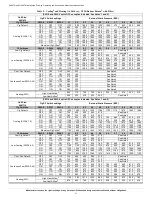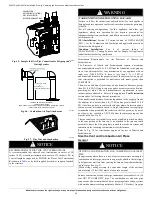
F96VTN and G96VTN: Installation, Start-up, Operating and Service and Maintenance Instructions
Manufacturer reserves the right to change, at any time, specifications and designs without notice and without obligations.
33
Venting Systems
Direct Vent / 2-Pipe System
In a direct-vent (2-pipe) system, all air for combustion is taken directly
from outdoor atmosphere, and all flue products are discharged to outdoor
atmosphere. Combustion-air and vent pipes must terminate together in
the same atmospheric pressure zone, either through the roof (preferred)
or a sidewall. See
for references to clearances required by
National code authorities.
Ventilated Combustion Air Systems
In a ventilated combustion air option, the vent terminates and discharges
the flue products directly to the outdoors similar to a direct vent system.
See
for references to clearances required by National code
authorities.
All air for combustion is piped directly to the furnace from a space that is
well ventilated with outdoor air (such as an attic or crawl space) and the
space is well isolated from the living space or garage. Combustion air
requirements for this option are the same as the requirements for
providing outside air for combustion for a single pipe vent system. Refer
to the “Air For Combustion and Ventilation” Section.
Table 12 – Vent Termination Kit for Direct Vent (2-pipe) Systems
NOTICE
!
OPTIONAL CONFIGURATION FOR COMBUSTION AIR INLET
PIPE
In applications where there is a risk of excessive moisture entering the
combustion air inlet pipe, a moisture trap may be added to the inlet pipe
to help prevent moisture from entering the furnace from the combustion
air inlet pipe. See
When sizing venting systems, the equivalent length of the optional inlet
pipe moisture trap must be taken into account.
NOTICE
!
RECOMMENDED SUPPORT FOR VENT TERMINATION
It is recommended that sidewall vent terminations of over 24 inches
(0.6 M) in length or rooftop vent terminations of over 36 inches (1 M)
in length be supported by EITHER the factory accessory vent
termination kit or field-supplied brackets or supports attached to the
structure. A factory accessory vent termination kit may be used for
direct vent terminations. Termination kits are available for 2-in. or 3-in.
pipe. See
NOTICE
!
OPTIONAL CONFIGURATION FOR COMBUSTION AIR INLET
PIPE
In applications where there is a risk of excessive moisture entering the
combustion air inlet pipe, a moisture trap may be added to the inlet pipe
to help prevent moisture from entering the furnace from the combustion
. When sizing venting systems, the equivalent
length of the optional inlet pipe moisture trap must be taken into
account.
WARNING
!
CARBON MONOXIDE POISONING HAZARD
Failure to follow the steps outlined below for each appliance connected
to the venting system being placed into operation could result in carbon
monoxide poisoning or death.
The following steps shall be followed for each appliance connected to
the venting system being placed into operation, while all other
appliances connected to the venting system are not in operation:
1. Seal any unused openings in venting system.
2. Inspect the venting system for proper size and horizontal pitch, as
required in the National Fuel Gas Code, ANSI Z223.1/NFPA 54 or
the CSA B149 Natural Gas and Propane Installation Code and
these instructions. Determine that there is no blockage or
restriction, leakage, corrosion and other deficiencies, which could
cause an unsafe condition.
3. As far as practical, close all building doors and windows and all
doors between the space in which the appliance(s) connected to
the venting system are located and other spaces of the building.
4. Close fireplace dampers.
5. Turn on clothes dryers and any appliance not connected to the
venting system. Turn on any exhaust fans, such as range hoods and
bathroom exhausts, so they are operating at maximum speed. Do
not operate a summer exhaust fan.
6. Follow the lighting instructions. Place the appliance being
inspected into operation. Adjust the thermostat so appliance is
operating continuously.
7. Test for spillage from draft hood equipped appliances at the draft
hood relief opening after 5 minutes of main burner operation. Use
the flame of a match or candle.
8. If improper venting is observed during any of the above tests, the
venting system must be corrected in accordance with the National
Fuel Gas Code, ANSI Z223.1/NFPA 54 and/or CSA B149.1
Natural Gas and Propane Installation Code.
9. After it has been determined that each appliance connected to the
venting system properly vents when tested as outlined above,
return doors, windows, exhaust fans, fireplace dampers and any
other gas-fired burning appliance to their previous conditions of
use.
Vent and Combustion
Air Pipe Diameters
Approved Two-Pipe Termination Fittings
Allowable Concentric
Vent Kit
Concentric Vent
Kit
1 1/2-in.
(38 mm)
2-in.
(51 mm)
2 1/2-in.
(64 mm)
3-in.
(76-mm)
4-in.
(102 mm)
1 1/2-in. (38 mm)
No
Yes
No
No
No
2-in. (51 mm)
NAHA002CV
2-in. (51 mm)
No
Yes
No
No
No
2-in. (51 mm)
NAHA002CV
2 1/2-in. (64 mm)
No
No
No
Yes
No
2-in. (51 mm)
3-in. (76 mm)
NAHA002CV
NAHA001CV
3-in. (76-mm)
No
No
No
Yes
No
3-in. (76 mm)
NAHA001CV
4-in. (102 mm)
No
No
No
Yes
Yes
3-in. (76 mm)
NAHA001CV
















































